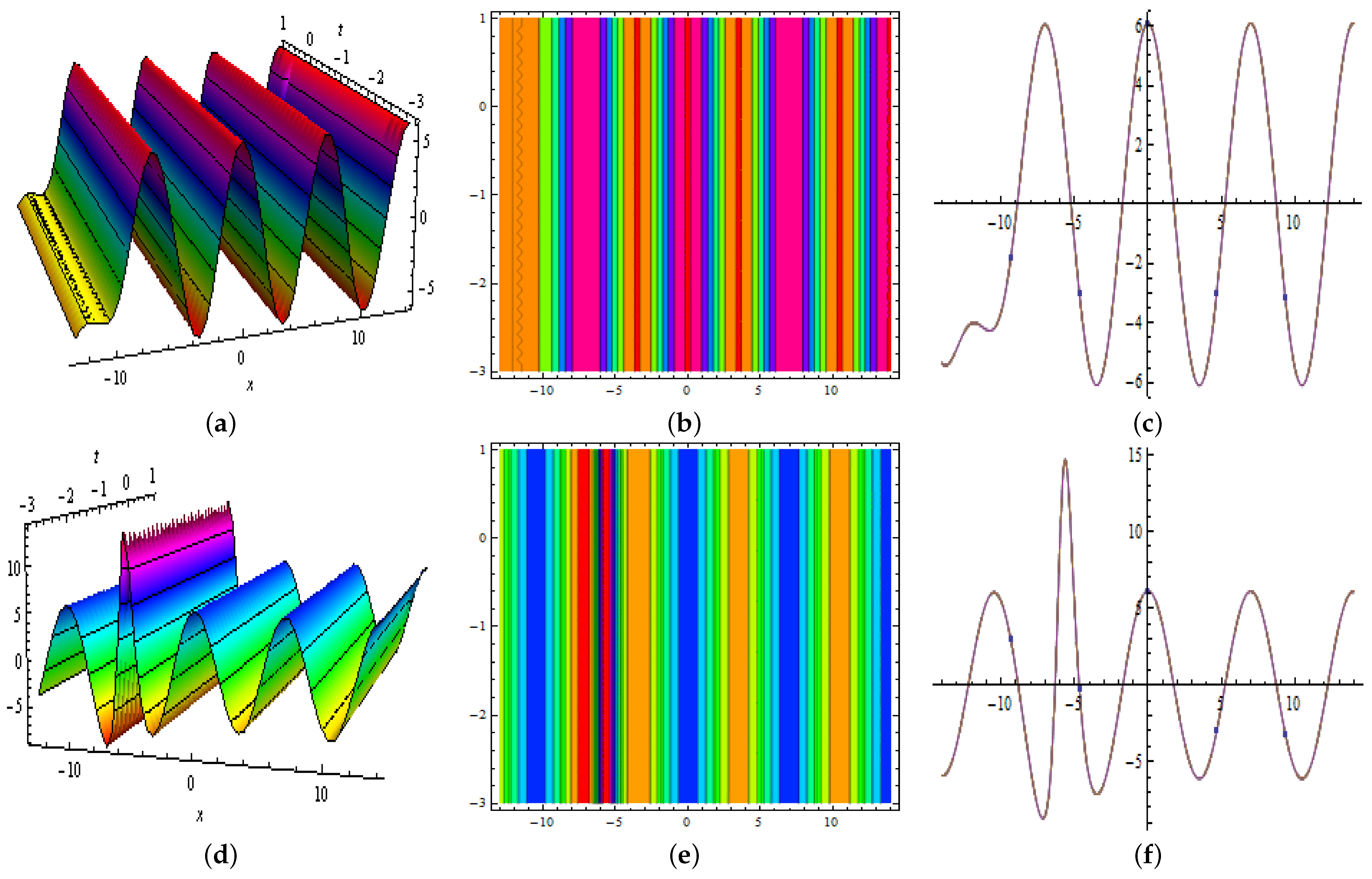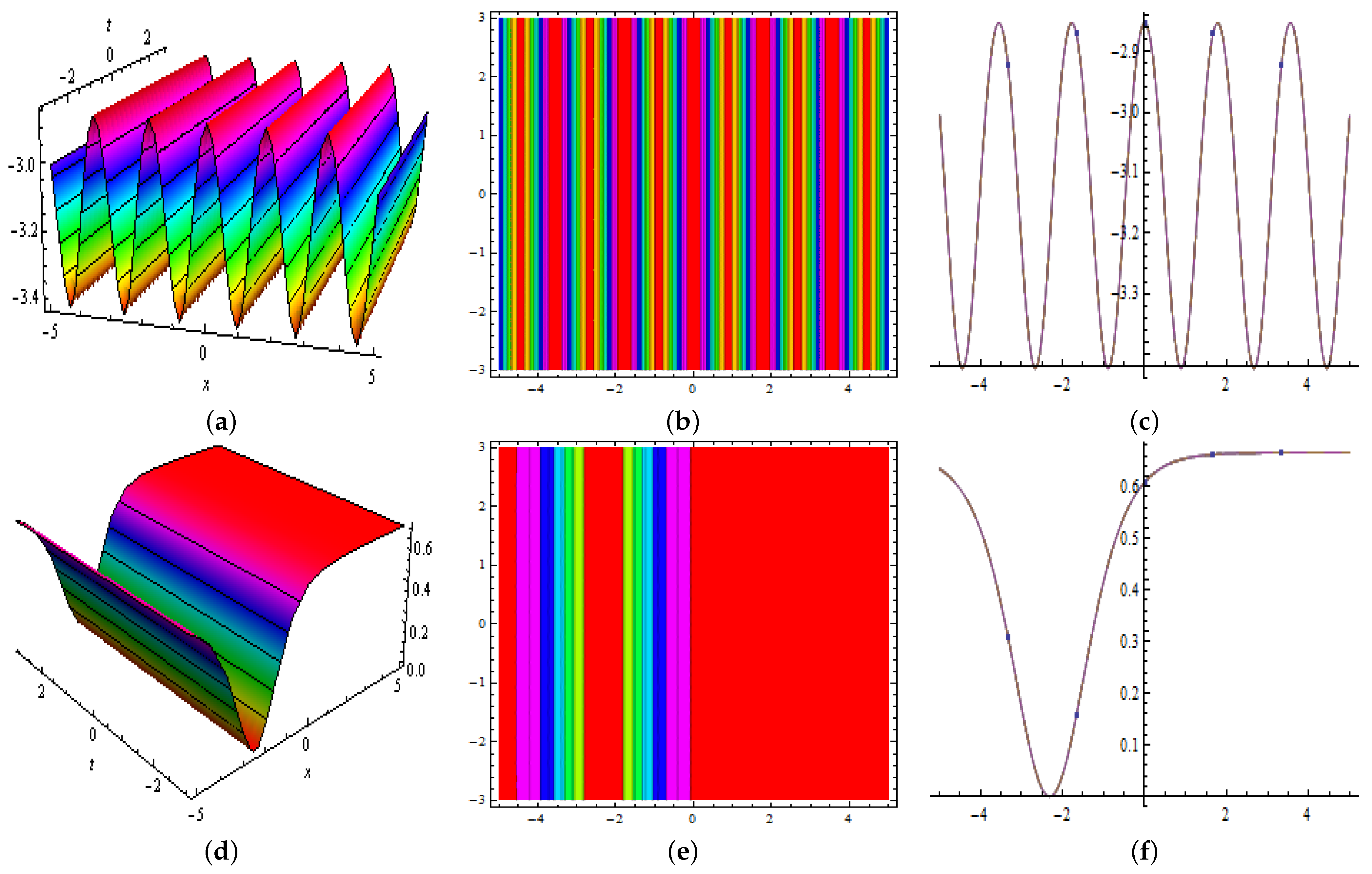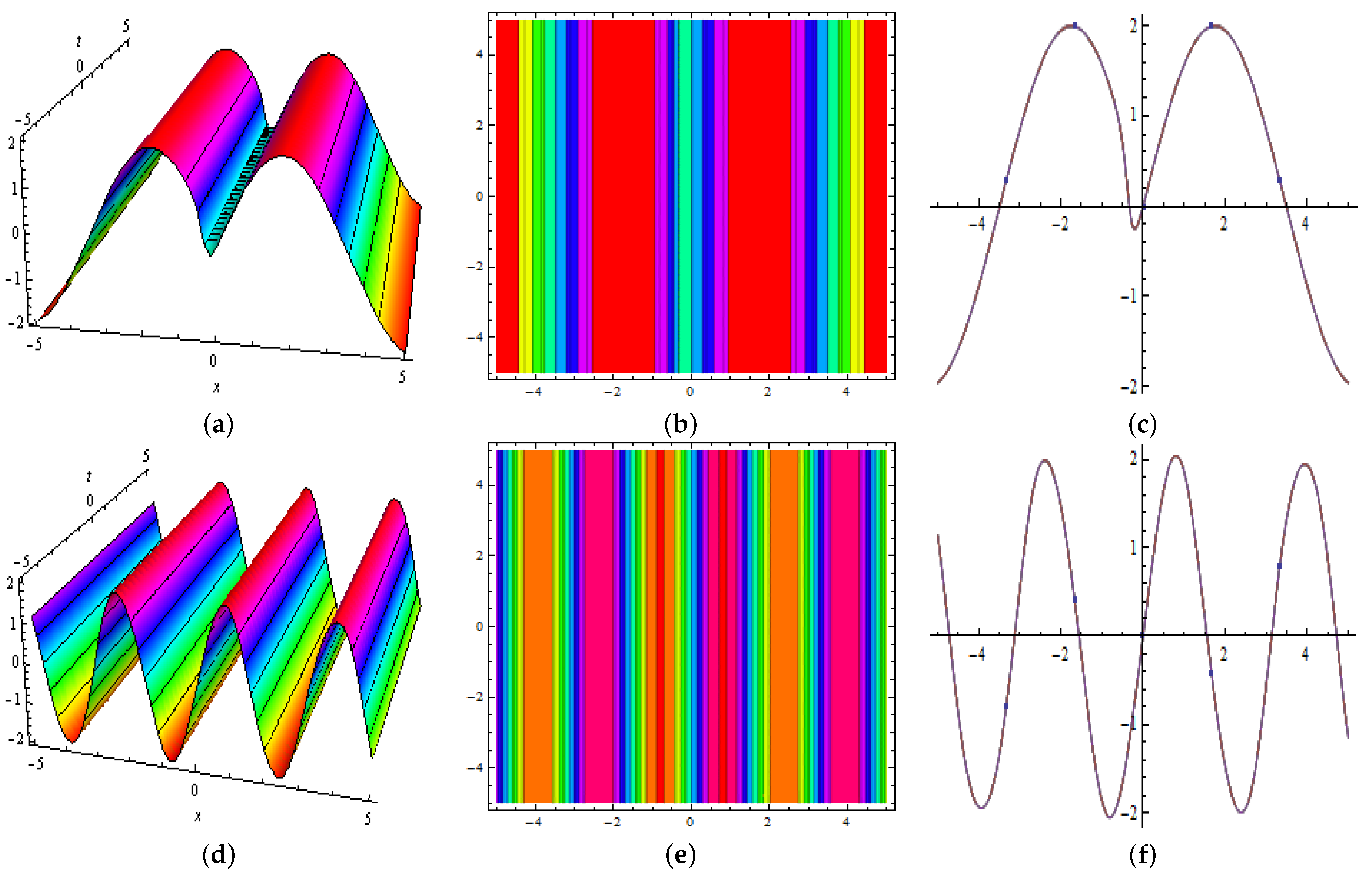Diverse Multiple Lump Analytical Solutions for Ion Sound and Langmuir Waves
Abstract
:1. Introduction
2. M-Shaped Rational Solitons
3. M-Shaped Rational Soliton Interactions with
3.1. One-Kink Soliton
3.2. Two-Kink Soliton
3.3. Periodic Waves
4. Multiwave Solutions
5. Homoclinic Breather Approach
6. The Periodic Cross-Kink Wave Solutions
7. Results and Discussion
8. Conclusions
Author Contributions
Funding
Institutional Review Board Statement
Informed Consent Statement
Data Availability Statement
Acknowledgments
Conflicts of Interest
References
- Dalir, M.; Bashour, M. Applications of Fractional Calculus. Appl. Math. Sci. 2010, 4, 1021–1032. [Google Scholar]
- Özkan, Y.S.; Seadawy, A.R.; Yaşar, E. Multi-wave, breather and interaction solutions to (3 + 1) dimensional Vakhnenko–Parkes equation arising at propagation of high-frequency waves in a relaxing medium. J. Taibah Univ. Sci. 2021, 15, 666–678. [Google Scholar] [CrossRef]
- Lu, D.; Seadawy, A.R.; Iqbal, M. Mathematical physics via construction of traveling and solitary wave solutions of three coupled system of nonlinear partial differential equations and their applications. Results Phys. 2018, 11, 1161–1171. [Google Scholar] [CrossRef]
- Seadawy, A.R.; Ali, A.; Albarakati, W.A. Analytical wave solutions of the (2 + 1)-dimensional first integro-differential Kadomtsev-Petviashivili hierarchy equation by using modified mathematical methods. Results Phys. 2019, 15, 102775. [Google Scholar] [CrossRef]
- Seadawy, A.R.; Cheemaa, N. Propagation of nonlinear complex waves for the coupled nonlinear Schrödinger Equations in two core optical fibers. Phys. A Stat. Mech. Its Appl. 2019, 529, 121330. [Google Scholar] [CrossRef]
- Kudryashov, N.A. The generalized Duffing oscillator. Commun. Nonlinear Sci. Numer. Simulat. 2021, 93, 105526. [Google Scholar] [CrossRef]
- Kudryashov, N.A. Model of propagation pulses in an optical fiber with a new law of refractive index. Optik 2021, 248, 168160. [Google Scholar] [CrossRef]
- Kudryashov, N.A. Solitary waves of the non-local Schrödinger equation with arbitrary refractive index. Optik 2021, 231, 166443. [Google Scholar] [CrossRef]
- Kudryashov, N.A. Almost general solution of the reduced higher-order nonlinear Schrödinger equation. Optik 2021, 230, 166347. [Google Scholar] [CrossRef]
- Kudryashov, N.A. Periodic and solitary waves in optical fiber Bragg gratings with dispersive reflectivity. Chin. J. Phys. 2020, 66, 401–405. [Google Scholar] [CrossRef]
- Rizvi, S.T.R.; Seadawy, A.R.; Younis, M.; Ahmad, N.; Zaman, S. Optical dromions for perturbed fractional nonlinear Schrödinger equation with conformable derivatives. Opt. Quantum Electron. 2021, 53, 477. [Google Scholar] [CrossRef]
- Younas, U.; Younis, M.; Seadawy, A.R.; Rizvi, S.T.R.; Althobaiti, S.; Sayed, S. Diverse exact solutions for modified nonlinear Schrödinger equation with conformable fractional derivative. Results Phys. 2021, 20, 103766. [Google Scholar] [CrossRef]
- Mohammadi, H.; Kumar, S.; Rezapour, S.; Etemad, S. A theoretical study of the Caputo–Fabrizio fractional modeling for hearing loss due to Mumps virus with optimal control. Chaos Solitons Fractals 2021, 144, 110668. [Google Scholar] [CrossRef]
- Nisar, K.S.; Jothimani, K.; Kaliraj, K.; Ravichandran, C. An analysis of controllability results for nonlinear Hilfer neutral fractional derivatives with non-dense domain. Chaos Solitons Fractals 2021, 146, 110915. [Google Scholar] [CrossRef]
- Kaliraj, K.; Thilakraj, E.; Ravichandran, C.; Nisar, K.S. Controllability analysis for impulsive integro-differential equation via Atangana–Baleanu fractional derivative. Math. Methods Appl. Sci. 2020. [Google Scholar] [CrossRef]
- Panda, S.K.; Ravichandran, C.; Hazarika, B. Ravichandran, Bipan Hazarika, Results on system of Atangana–Baleanu fractional order Willis aneurysm and nonlinear singularly perturbed boundary value problems. Chaos Solitons Fractals 2021, 142, 110390. [Google Scholar] [CrossRef]
- Younas, U.; Seadawy, A.R.; Younis, M.; Rizvi, S. Construction of analytical wave solutions to the conformable fractional dynamical system of ion sound and Langmuir waves. Waves Random Complex Media 2020, 32, 1–19. [Google Scholar] [CrossRef]
- Akram, U.; Seadawy, A.R.; Rizvi, S.T.R.; Younis, M.; Althobaiti, S.; Sayed, S. Traveling waves solutions for the fractional Wazwaz Benjamin Bona Mahony model in arising shallow water waves. Results Phys. 2021, 20, 103725. [Google Scholar] [CrossRef]
- Dokuyucua, M.A. Caputo and Atangana-Baleanu-Caputo Fractional Derivative Applied to Garden Equation. Turk. J. Sci. 2020, 5, 1–7. [Google Scholar]
- Seadawy, A.R. Modulation instability analysis for the generalized derivative higher order nonlinear Schrödinger equation and its the bright and dark soliton solutions. J. Electromagn. Waves Appl. 2017, 31, 1353–1362. [Google Scholar] [CrossRef]
- Zhang, S.; Zong, Q.A.; Liu, D.; Gao, Q. A generalized exp-function method for fractional Riccati differential equations. Commun. Fract. Calc. 2010, 1, 48–51. [Google Scholar]
- Seadawy, A.R.; Tariq, K.U. On some novel solitons to the generalized (1 + 1)-dimensional unstable spacetime fractional nonlinear Schrödinger model emerging in the optical fibers. Opt. Quantum Electron. 2021, 53, 1–16. [Google Scholar] [CrossRef]
- Chen, C.; Jiang, Y.; Wang, Z.; Wu, J. Dynamical behavior and exact solutions for time-fractional nonlinear Schrödinger equation with parabolic law nonlinearity. Optik 2020, 222, 165331. [Google Scholar] [CrossRef]
- Khan, S.A.; Shah, K.; Kumam, P.; Seadawy, A.; Zaman, G.; Shah, Z. Study of mathematical model of Hepatitis B under Caputo-Fabrizo derivative. AIMS Math. 2021, 6, 195–209. [Google Scholar] [CrossRef]
- Seadawy, A.R.; Bilal, M.; Younis, M.; Rizvi, S.; Althobaiti, S.; Makhlouf, M. Analytical mathematical approaches for the double-chain model of DNA by a novel computational technique. Chaos Solitons Fractals 2021, 144, 110669. [Google Scholar] [CrossRef]
- Farah, N.; Seadawy, A.R.; Ahmad, S.; Rizvi, S.T.R.; Younis, M. Interaction properties of soliton molecules and Painleve analysis for nano bioelectronics transmission model. Opt. Quantum Electron. 2020, 52, 1–15. [Google Scholar] [CrossRef]
- Helal, M.A.; Seadawy, A.R. Variational method for the derivative nonlinear Schrödinger equation with computational applications. Phys. Scr. 2009, 80, 350–360. [Google Scholar] [CrossRef]
- Gaber, A.A.; Aljohani, A.F.; Ebaid, A.; Machado, J.T. The generalized Kudryashov method for nonlinear space-time fractional partial differential equations of Burgers type. Nonlinear Dyn. 2019, 95, 361–368. [Google Scholar] [CrossRef]
- Ghaffar, A.; Ali, A.; Ahmed, S.; Akram, S.; Junjua, M.-U.-D.; Baleanu, D.; Nisar, K.S. A novel analytical technique to obtain the solitary solutions for nonlinear evolution equation of fractional order. Adv. Differ. Equ. 2020, 2020, 308. [Google Scholar] [CrossRef]
- Rizvi, S.T.R.; Ali, K.; Ahmad, M. Optical solitons for Biswas–Milovic equation by new extended auxiliary equation method. Optik 2020, 204, 164181. [Google Scholar] [CrossRef]
- Ahmed, I.; Seadawy, A.R.; Lu, D. M-shaped rational solitons and their interaction with kink waves in the Fokas–Lenells equation. Phys. Scr. 2019, 94, 055205. [Google Scholar] [CrossRef]
- Ahmed, I.; Seadawy, A.R.; Lu, D. Kinky breathers, W-shaped and multi-peak solitons interaction in (2 + 1)-dimensional nonlinear Schrödinger equation with Kerr law of nonlinearity. Eur. Phys. J. Plus 2019, 134, 120. [Google Scholar] [CrossRef]
- Ma, H.; Zhang, C.; Deng, A. New Periodic Wave, Cross-Kink Wave, Breather, and the Interaction Phenomenon for the (2+1)-Dimensional Sharmo–Tasso–Olver Equation. Complexity 2020, 2020, 4270906. [Google Scholar] [CrossRef]
- Mohammed, W.W.; Abdelrahman, M.A.E.; Inc, M.; Hamza, A.E.; Akinlar, M.A. Soliton solutions for system of ion sound and Langmuir waves. Opt. Quantum Electron. 2020, 52, 1–10. [Google Scholar] [CrossRef]
- Shakeel, M.; Iqbal, M.A.; Din, Q.; Hassan, Q.M.; Ayub, K. New exact solutions for coupled nonlinear system of ion sound and Langmuir waves. Indian J. Phys. 2019, 94, 885–894. [Google Scholar] [CrossRef]
- Seadawy, A.R.; Lu, D.; Iqbal, M. Application of mathematical methods on the system of dynamical equations for the ion sound and Langmuir waves. Pramana 2019, 93, 1–12. [Google Scholar] [CrossRef]
- Tripathy, A.; Sahoo, S. Exact solutions for the ion sound Langmuir wave model by using two novel analytical methods. Results Phys. 2020, 19, 103494. [Google Scholar] [CrossRef]
- Seadawy, A.R.; Kumar, D.; Hosseini, K.; Samadani, F. The system of equations for the ion sound and Langmuir waves and its new exact solutions. Results Phys. 2018, 9, 1631–1634. [Google Scholar] [CrossRef]



















Publisher’s Note: MDPI stays neutral with regard to jurisdictional claims in published maps and institutional affiliations. |
© 2022 by the authors. Licensee MDPI, Basel, Switzerland. This article is an open access article distributed under the terms and conditions of the Creative Commons Attribution (CC BY) license (https://creativecommons.org/licenses/by/4.0/).
Share and Cite
Alruwaili, A.D.; Seadawy, A.R.; Rizvi, S.T.R.; Beinane, S.A.O. Diverse Multiple Lump Analytical Solutions for Ion Sound and Langmuir Waves. Mathematics 2022, 10, 200. https://doi.org/10.3390/math10020200
Alruwaili AD, Seadawy AR, Rizvi STR, Beinane SAO. Diverse Multiple Lump Analytical Solutions for Ion Sound and Langmuir Waves. Mathematics. 2022; 10(2):200. https://doi.org/10.3390/math10020200
Chicago/Turabian StyleAlruwaili, Abdulmohsen D., Aly R. Seadawy, Syed T. R. Rizvi, and Sid Ahmed O. Beinane. 2022. "Diverse Multiple Lump Analytical Solutions for Ion Sound and Langmuir Waves" Mathematics 10, no. 2: 200. https://doi.org/10.3390/math10020200




